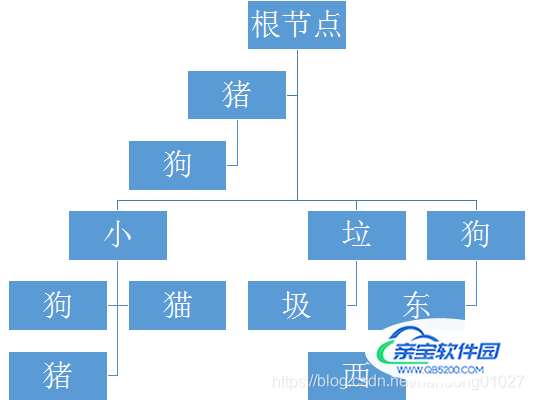JAVA使用前缀树(Tire树)实现敏感词过滤、词典搜索
萌萌哒二狗子 人气:0简介
有时候需要对用户输入的内容进行敏感词过滤,或者实现查找文本中出现的词典中的词,用遍历的方式进行替换或者查找效率非常低,这里提供一个基于Trie树的方式,进行关键词的查找与过滤,在词典比较大的情况下效率非常高。
Trie树
Trie树,又叫前缀树,多说无益,直接看图就明白了
词典:[“猪狗”, “小狗”, “小猫”, “小猪”, “垃圾”, “狗东西”]
Tire数据结构:

code
树节点Node.class
/**
* trie tree
*
* @author lovely dog
* @date 2020/10/20
*/
public class Node {
/**
* 子节点
*/
private Map<Character, Node> nextNodes = new HashMap<>();
public void addNext(Character key, Node node){
nextNodes.put(key, node);
}
public Node getNext(Character key){
return nextNodes.get(key);
}
public boolean isLastCharacter(){
return nextNodes.isEmpty();
}
}
搜索类TrieSearcher.class
/**
* trie tree searcher
*
* @author lovely dog
* @date 2020/10/20
*/
public class TrieSearcher {
private Node root = new Node();
/**
* 添加词
*
* @param word 词
*/
public void addWord(String word) {
Node tmpNode = root;
for (char c : word.toCharArray()) {
Node node = tmpNode.getNext(c);
if (null == node) {
node = new Node();
tmpNode.addNext(c, node);
}
tmpNode = node;
}
}
/**
* 替换词
*
* @param text 待处理文本
* @param afterReplace 替换后的词
* @return 处理后的文本
*/
public String replace(String text, String afterReplace) {
StringBuilder result = new StringBuilder(text.length());
Node tmpNode = root;
int begin = 0, pos = 0;
while (pos < text.length()) {
char c = text.charAt(pos);
tmpNode = tmpNode.getNext(c);
if (null == tmpNode) {
result.append(text.charAt(begin));
begin++;
pos = begin;
tmpNode = root;
} else if (tmpNode.isLastCharacter()) {
// 匹配完成, 进行替换
result.append(afterReplace);
pos++;
begin = pos;
tmpNode = root;
} else {
// 匹配上向后移
pos++;
}
}
result.append(text.substring(begin));
return result.toString();
}
/**
* 查找
*
* @param text 待处理文本
* @return 统计数据 key: word value: count
*/
public Map<String, Integer> find(String text) {
Map<String, Integer> resultMap = new HashMap<>(16);
Node tmpNode = root;
StringBuilder word = new StringBuilder();
int begin = 0, pos = 0;
while (pos < text.length()) {
char c = text.charAt(pos);
tmpNode = tmpNode.getNext(c);
if (null == tmpNode) {
begin++;
pos = begin;
tmpNode = root;
} else if (tmpNode.isLastCharacter()) {
// 匹配完成
String w = word.append(c).toString();
resultMap.put(w, resultMap.getOrDefault(w, 0) + 1);
pos++;
begin = pos;
tmpNode = root;
word = new StringBuilder();
} else {
// 匹配上向后移
word.append(c);
pos++;
}
}
return resultMap;
}
}
测试Main.class
public class Main {
public static void main(String[] args) {
TrieSearcher trieSearcher = new TrieSearcher();
Stream.of("猪狗", "小狗", "小猫", "小猪", "垃圾", "狗东西").forEach(trieSearcher::addWord);
String sentence = "你好,小狗,小猪,今天天气真好。";
System.out.println(trieSearcher.replace(sentence, "***"));
System.out.println(trieSearcher.find(sentence));
}
}
输出:
你好,***,***,今天天气真好。
{小猪=1, 小狗=1}
Benchmark:
replace 1093.517 ns/op
trie 200.042 ns/op
结论
在仅有短文本和小词典的情况下,通过性能测试可以看出前缀树的效率很高,随着文本和词典的增长,性能提升会非常明显。
加载全部内容